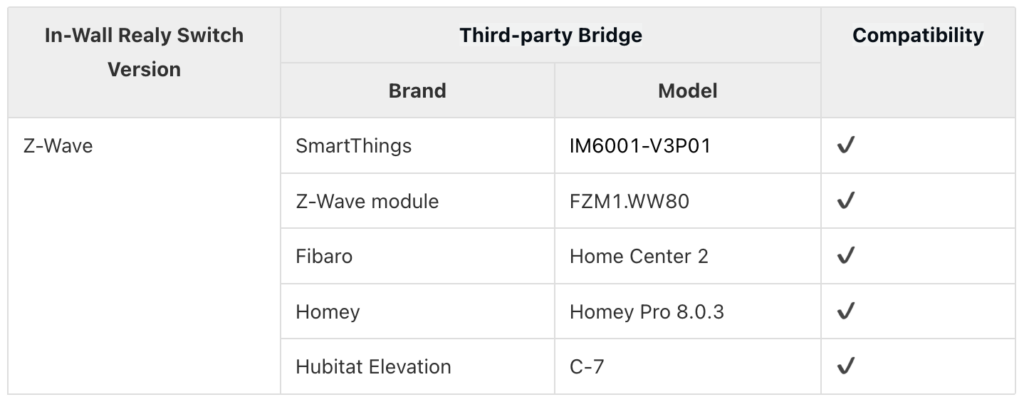This document describes the questions you may want to know when you use the In-Wall Relay Switch:
- In which countries can I use the In-Wall Relay Switch?
- What kinds of loads does the In-Wall Relay Switch support?
- Why is the In-Wall Relay Switch designed in two parts: the Smart Relay, and the Smart Switch Sub-Assembly?
- What types of wall switches does the Smart Switch Sub-Assembly support?
- How many gangs of wall switches does the Smart Switch Sub-Assembly support?
- The Smart Switch Sub-Assembly has two gangs. Does each gang support 3A current? Or do the two gangs combined support 3A current in total?
- Does the In-Wall Relay Switch support groups of lights and/or 3-way control?
- What if the In-Wall Relay Switch is overloaded? Are there any safety hazards?
- To what certifications does the In-Wall Relay Switch conform?
- What Zigbee gateways is the In-Wall Relay Switch compatible with?
- What Z-Wave gateways is the In-Wall Relay Switch compatible with?
- How do I know whether Z-Wave is supported in my region?
1. In which countries can I use the In-Wall Relay Switch?
The In-Wall Relay Switch can be used in any country. It is compatible with power sources ranging from 85-245 V AC and 50/60 Hz.
2. What kinds of loads does the In-Wall Relay Switch support?
The In-Wall Relay Switch supports a variety of loads, including lights, fans, etc. The maximum power output is AC 110 V/300 W; AC 220 V/600 W. There is no minimum power requirement for the In-Wall Relay Switch to work properly.
3. Why is the In-Wall Relay Switch designed in two parts: the Smart Relay, and the Smart Switch Sub-Assembly?
The two-part design of our In-Wall Relay Switch system is what makes it such a groundbreaking and advanced system.
The Smart Relay, which is installed near the light/load, allows for remote control of the load.
The Smart Switch Sub-Assembly, on the other hand, is installed near the switch. It requires no neutral wire for installation and supports various types of traditional switches. This Sub-Assembly should be installed if you want to also maintain traditional switch control of your light/load.
Designing this system in two parts has many benefits:
- More compatible. Before the introduction of our two-part system, every other “no-neutral smart switch” solution on the market had a common issue: when the mechanical wall switch was turned off, the circuit would still allow a small amount of current to pass through, causing the lighting fixture to blink. Our In Wall Relay Switch system completely solves this problem; you’ll never have another blinking light fixture with our two-part system. Further, the In-Wall Relay Switch has no restrictions on the type or minimum power consumption of lights you attach to the system, virtually making it a universally compatible product.
- Smaller. The Smart Switch Sub-Assembly module has been designed to be incredibly small, making it compatible with the vast majority of electric boxes.
- More reliable. The two parts of the system are hardwire connected. Even if the wireless network cuts out, you can still control the load with the traditional switch on the wall.
- Adaptable to more scenarios. This system allows for greater flexibility in combining and pairing the two parts of the system, meaning it can adapt to a variety of switch scenarios, including group lights, multi-way control, etc.
4. What types of wall switches does the Smart Switch Sub-Assembly support?
The Smart Switch Sub-Assembly supports both rocker switches and push button switches.
5. How many gangs of wall switches does the Smart Switch Sub-Assembly support?
One Smart Switch Sub-Assembly supports up to a two-gang switch. If your switch is one-gang, simply leave the SW2 and L2 terminals of the Sub-Assembly disconnected (only connect SW1 and L1). Of course, you can also install two Smart Switch Sub-Assemblies in the same electric box to support three-gang or four-gang switches.
6. The Smart Switch Sub-Assembly has two gangs. Does each gang support 3A current? Or do the two gangs combined support 3A current in total?
The two gangs combined support 3A current in total. For example, if the first gang is connected to a 1A load, the second gang can only be connected to a load of 2A or lower.
7. Does the In-Wall Relay Switch support groups of lights and/or 3-way control?
Yes, the In-Wall Relay Switch supports both. The two parts of the product can be flexibly combined to adapt to various application scenarios. Refer to Wiring Tutorial for detailed wiring diagrams.
8. What if the In-Wall Relay Switch is overloaded? Are there any safety hazards?
If the In-Wall Relay Switch is overloaded slightly, the Relay cuts power to the load automatically; if it is overloaded severely, the internal fuse of the Relay is blown to protect the circuit. As such, overloads do not pose a safety concern, but they do affect the way the device performs.
9. To what certifications does the In-Wall Relay Switch conform?
The In-Wall Relay Switch conforms to CE, FCC, UKCA, RoHS, WEEE, and SRRC standards. Additionally, the versions that work with different protocols have passed their corresponding protocol certifications, such as Works with Apple Home, Zigbee 3.0, and Z-Wave Plus.
10. What Zigbee gateways is the In-Wall Relay Switch compatible with?
The In-Wall Relay Switch (Zigbee) is compatible with most of the gateways on the market that conform to the Zigbee standard protocol. The list of compatible gateways we have tested is as follows:

11. What Z-Wave gateways is the In-Wall Relay Switch compatible with?
The In-Wall Relay Switch (Z-Wave) is compatible with most gateways on the market that conform to the Z-Wave standard protocol. The list of compatible gateways we have tested is as follows:

12. How do I know whether Z-Wave is supported in my region?
You can check on the Silicon Labs official website: https://z-wavealliance.org/z-wave-global-regions/.